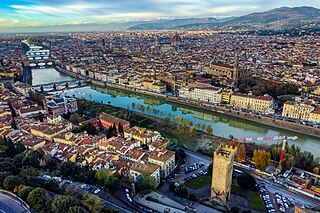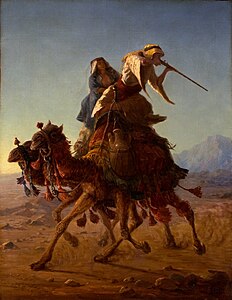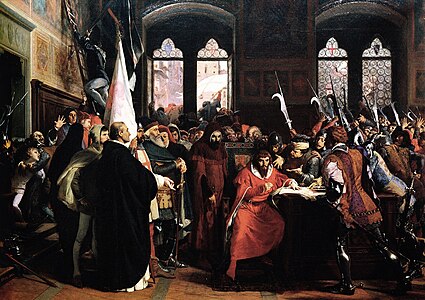
Florence is the capital city of the Italian region of Tuscany. It is also the most populated city in Tuscany, with 360,930 inhabitants in 2023, and 984,991 in its metropolitan area.

Paolo Uccello, born Paolo di Dono, was an Italian painter and mathematician who was notable for his pioneering work on visual perspective in art. In his book Lives of the Most Excellent Painters, Sculptors, and Architects, Giorgio Vasari wrote that Uccello was obsessed by his interest in perspective and would stay up all night in his study trying to grasp the exact vanishing point. Uccello used perspective to create a feeling of depth in his paintings. His best known works are the three paintings representing the battle of San Romano, which were wrongly entitled the Battle of Sant'Egidio of 1416 for a long period of time.

The Palazzo Pitti, in English sometimes called the Pitti Palace, is a vast, mainly Renaissance, palace in Florence, Italy. It is situated on the south side of the River Arno, a short distance from the Ponte Vecchio. The core of the present palazzo dates from 1458 and was originally the town residence of Luca Pitti, an ambitious Florentine banker.

Agnolo di Cosimo, usually known as Bronzino or Agnolo Bronzino, was an Italian Mannerist painter from Florence. His sobriquet, Bronzino, may refer to his relatively dark skin or reddish hair.

Palazzo Mozzi or Palazzo de' Mozzi is an early Renaissance palace, located at the end of the Piazza de' Mozzi that emerges from Ponte alle Grazie and leads straight to the palace where via San Niccolò becomes via de' Bardi in the Quartiere of Santo Spirito in the Oltrarno section of Florence, region of Tuscany, Italy. The 13th-century palace housed the gallery of the highly successful antiquarian Stefano Bardini, of which the remnants were left to the commune, where they assembled the Museo Bardini or Mozzi Bardini, displaying Florentine art and artifacts up to the early Renaissance. The gardens elaborated against the hillside behind the palace were added mainly by Bardini.

Domenico Morelli was an Italian painter, who mainly produced historical and religious works. Morelli was immensely influential in the arts of the second half of the 19th century, both as director of the Accademia di Belle Arti in Naples, but also because of his rebelliousness against institutions: traits that flourished into the passionate, often patriotic, Romantic and later Symbolist subjects of his canvases. Morelli was the teacher of Vincenzo Petrocelli and Ulisse Caputo.

Giuseppe Bezzuoli was an Italian painter of the Neoclassic and Romantic periods.

Enrico Pollastrini was an Italian history painter and art school director.

Amos Cassiòli was an Italian painter, of battle scenes, historical canvases and portraits. He worked in a Purismo style.

Federico Andreotti was an Italian painter.

Cesare Biseo was an Italian painter, known primarily for his orientalist scenes.
Pietro Baldancoli was an Italian painter.

Giovanni Battista Quadrone was an Italian painter, mainly of genre scenes.

Gioacchino Toma was an Italian art instructor and painter, noted primarily for historic, realistic and genre subjects in a Romantic style.

Pompeo Marino Molmenti was an Italian painter.
Emanuele Serrano was an Italian sculptor, mainly in terracotta.

Alberto Pasini was an Italian painter. He is best known for depicting Orientalist subjects in a late-Romantic style.

Antonio Berti was an Italian painter, mainly portraits, landscapes, and romantic scenes.
Annibale Gatti was an Italian painter, known for history painting and fresco decoration in Tuscany.

Gaetano Capone (1845–1924) was an Italian painter, mostly depicting landscapes and genre subjects.






















